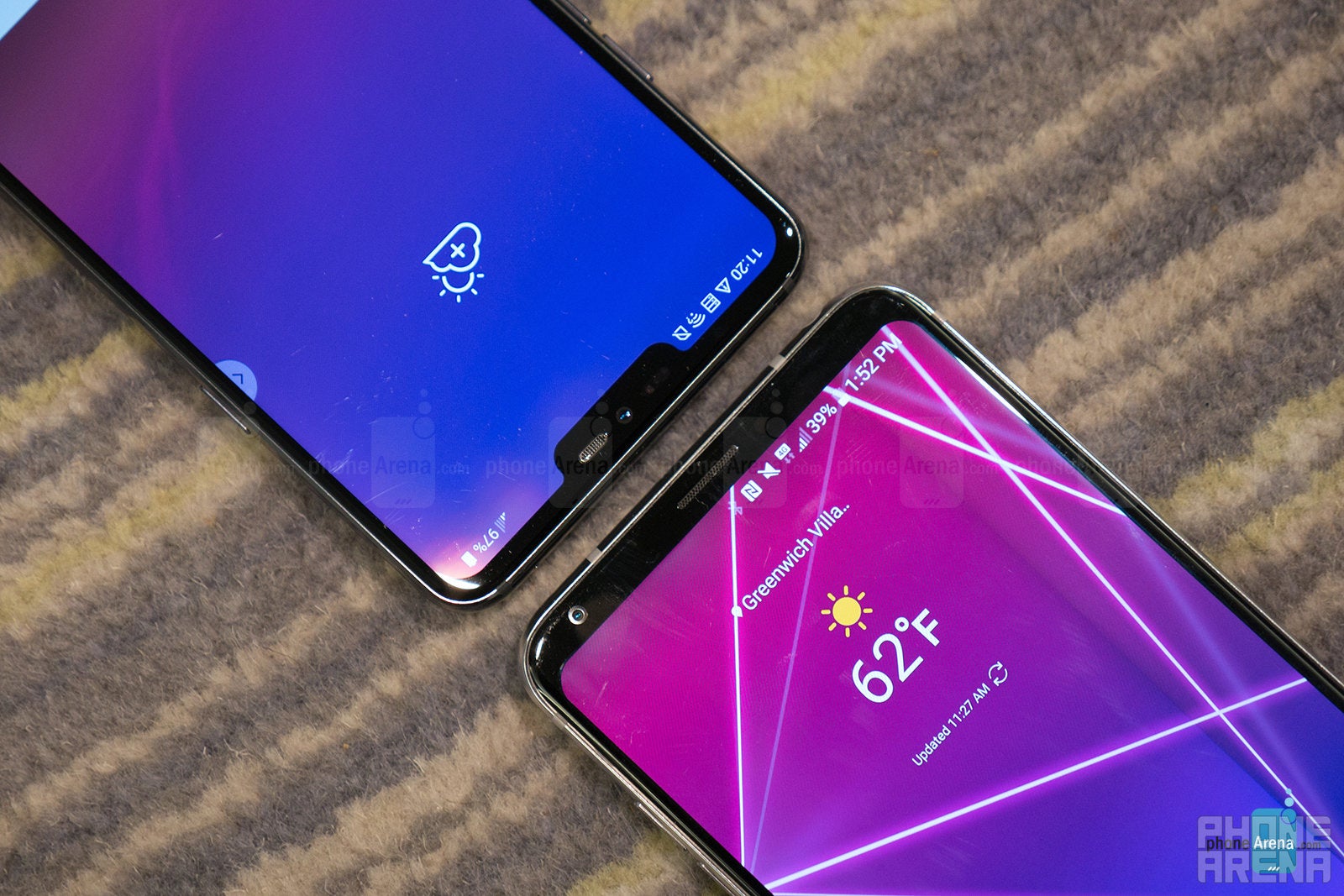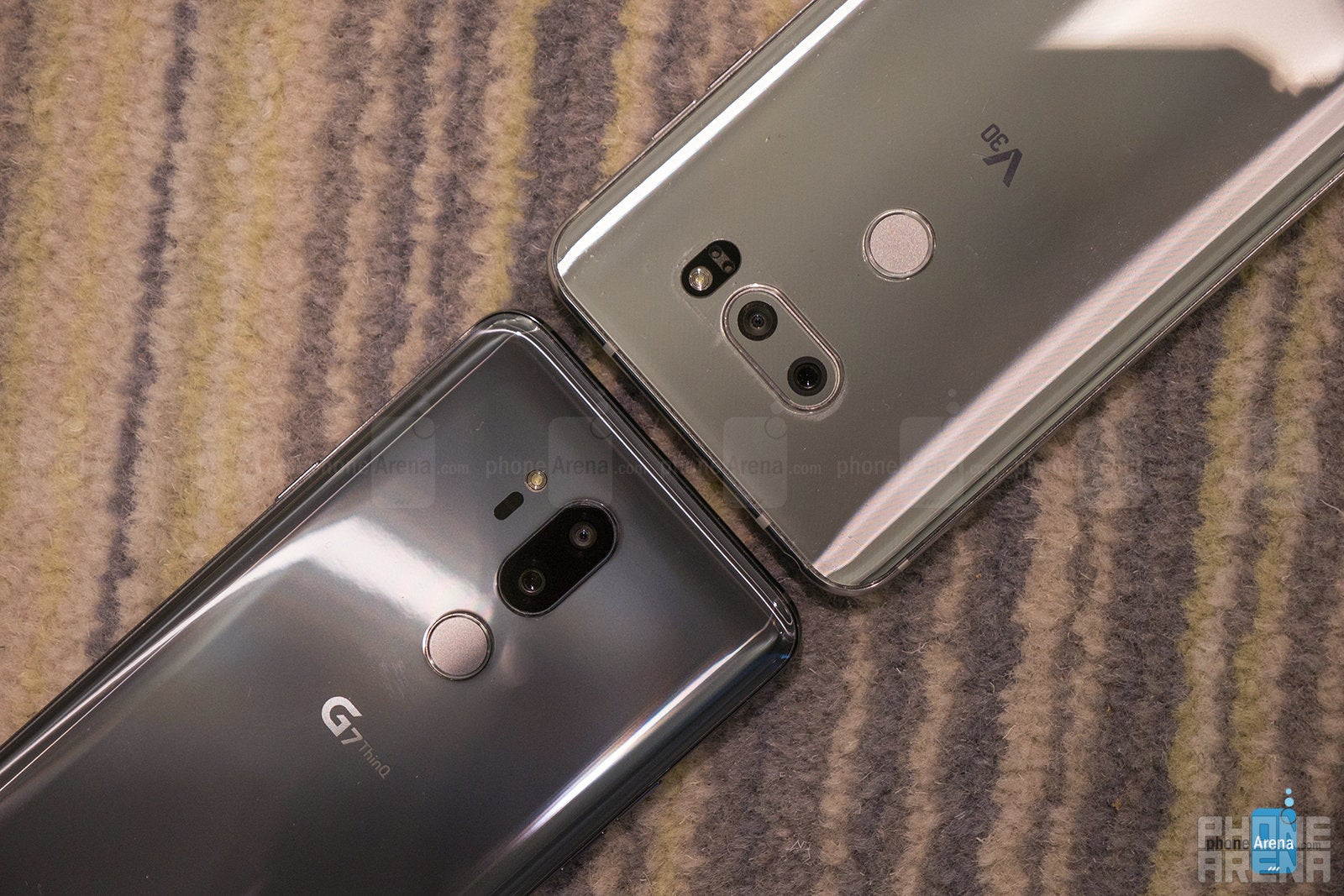LG G7 ThinQ vs LG V30: first look

They didn't get the recipe to our standards the first time around with the G6 last year in the spring, but by the time fall came around, they managed to hit it out of the ballpark with the V30. When we first feasted our eyes on it, the V30 looked and felt significantly more refined – while also proving itself as the most versatile camera phone around for recording video. Now that the LG G7 ThinQ is here, it's really going to need come at us with an even more compelling package if it has any chance of continuing LG's streak with the V30!
Design
Clearly LG loved the design they delivered with the V30, seeing that it's been slightly tweaked here with the G7 ThinQ. For the most part, these two smartphones share plenty of commonalities with their designs – starting with the glass meets metal constructions and curved edges. Although, it appears as though those curved edges extend to all four sides of the G7 ThinQ's chassis. What's interesting about the designs is that this time, it looks as though the G7 ThinQ matches the V30's overall footprint, which is a bit strange considering that the G-line traditionally has a smaller footprint than the V-series.
Display
Over on the specs side, the LG G7 ThinQ packs a 6.1-inch QHD+ (1440 x 3120) FullVision Display – while the V30 sizes up with a 6-inch QHD+ (1440 x 2880) OLED FullVision Display. Again, it's really hard to believe that the G7 is sporting the larger panel here, as the V-series has been typically the one with the larger screens. Then again, the G7 ThinQ introduces us to the notch, which does indeed occupy a little bit of space around the earpiece, but luckily it can be masked – making it appear very much like the V30.

User Interface
Superficially, it doesn't seem like there's a whole lot different in looking at their respective Android experience. Both are running Android 8.0 Oreo, complemented by LG's customizations – such the floating bar, Knock on, and mini view. Quite frankly, anyone who has handled the V30 will feel at home checking out the G7 ThinQ. Then again, the G7 ThinQ benefits largely from the artificial intelligence integration that LG has bestowed in it! So far, it's mostly related to the camera, voice integration, and home appliances.
Camera
One peculiar thing sticks out at us when looking at the back of both phones is how their dual cameras are positioned differently from one another, it's vertical with the V30 and horizontal with the G7 ThinQ. For the V30, its dual cameras break down to a 16MP main camera with an f/1.6 aperture and a 13MP 120-degree wide-angle secondary camera with an f/1.9 aperture. Meanwhile, the G7 ThinQ is treated to a pair of 16MP sensors broken down to a main 71-degree f/1.6 lens and a wide-angle 107-degree f/1.9 one. As you can tell, the V30 still achieves a wider reach, which is evident in some of the snapshots we captured.
The one distinct advantage going for the G7 ThinQ is its abilty to capture those creamy looking bokeh portrait shots that can make anyone seem like a professional in how they're able to separate the subject and background. It's the first time we're getting a real portrait mode on an LG smartphone, so we're excited about that! Moreover, it appears as though the G7 ThinQ has also inherited the V30's versatile video capture abilities, since it now features the same extensive manual controls and Cine modes. And lastly, the AI integration with the G7 ThinQ allows the camera to adjust to the scene to yield the best results.

Battery
Oddly enough, it's the V30 that's edging out its sibling in the battery department with its slightly larger 3300 mAh battery cell – versus the 3000 mAh one in the G7 ThinQ. Even though it's an advantage on paper for the V30, it's anyone's guess as to whether or not the G7 ThinQ will be able to match its sibling's longevity. At the very least, though, the two smartphones are equipped with wireless charging as an alternative to the usual wired connection with their USB Type-C ports.
Expectations
What LG is doing here with the G7 ThinQ is strange. First of all, there's no longer a clear-cut line separating the distinctive advantages of each series. In the past, the G-series was known to be the smaller handset with a heavier focus on still image photography, but that's all tossed upside down with the G7 ThinQ and how it encapsulates pretty much everything we found previously with the V30. To us, the G7 ThinQ seems more like a refined V30, despite the fact that the V30 already has its own line of variants.
Knowing all that, we're really eager to discover the G7 ThinQ's pricing. In all fairness, we wouldn't be too shocked if it somehow mirrored the V30's launch price of around $800, which is pricey considering all things. Therefore, it'd be more rational to have the G7 ThinQ at a lower price point than that, especially how the trends have always treated the V-series with the higher price point. If you already own the V30, there doesn't seem to be a whole lot of reason to make the switch – that's unless you want to capture those slick looking portrait shots.
Follow us on Google News









![A new Android bug is making it impossible to install new apps. Are you affected? [UPDATE]](https://m-cdn.phonearena.com/images/article/176703-wide-two_350/A-new-Android-bug-is-making-it-impossible-to-install-new-apps.-Are-you-affected-UPDATE.webp)

Things that are NOT allowed:
To help keep our community safe and free from spam, we apply temporary limits to newly created accounts: